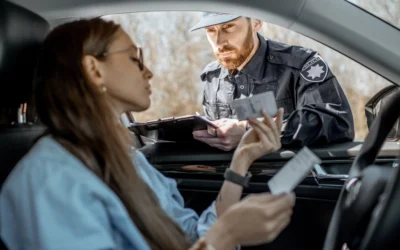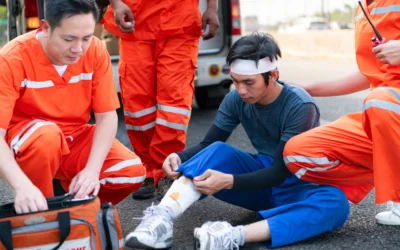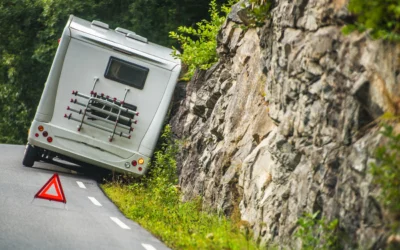The Moment That Changes Everything
You’re driving down Las Vegas Boulevard, enjoying the sights, when suddenly—CRASH. In the blink of an eye, your day is turned upside down. The screech of tires, the crunch of metal, the surge of adrenaline—a car accident instantly transforms your routine drive into a maze of questions, stress, and uncertainty.
What happens next could make the difference between a smooth recovery and a financial nightmare. Each year, thousands of Nevada drivers find themselves facing this exact situation, yet many are unprepared for the insurance claim process that follows. Understanding how to navigate insurance claims after a car accident in Nevada isn’t just helpful—it’s essential.
As a Nevada driver, you have specific rights and responsibilities that differ from other states. The decisions you make in the minutes, hours, and days after an accident can significantly impact your ability to recover physically, emotionally, and financially. That’s why we’ve created this comprehensive blog to help you through the process.
Understanding Nevada’s Car Insurance Framework
Nevada operates under an “at-fault” insurance system, meaning the driver responsible for causing an accident must pay for the resulting damages. This differs from “no-fault” states where each driver’s insurance covers their own damages regardless of who caused the accident.
The Minimum Coverage Requirements
Under Nevada law, all drivers must carry liability insurance with the following minimum coverage limits:
- $25,000 for bodily injury or death of one person
- $50,000 for bodily injury or death of two or more people
- $20,000 for property damage
This is commonly referred to as “25/50/20” coverage. These requirements were increased from the previous 15/30/10 limits in July 2018, reflecting the rising costs of medical care and vehicle repairs.
According to Nevada Revised Statutes (NRS) 485.185, driving without this minimum coverage is illegal and can result in serious penalties, including license suspension, registration suspension, and fines.
Additional Coverage Options
While liability insurance is the only legally required coverage, most insurance companies offer additional protection options that Nevada drivers should consider:
- Collision coverage: Pays for damage to your vehicle regardless of fault
- Comprehensive coverage: Covers non-collision damage like theft, vandalism, or weather events
- Medical Payments (MedPay): Covers medical expenses for you and your passengers regardless of fault
- Uninsured/Underinsured Motorist (UM/UIM): Protects you if you’re hit by a driver with insufficient or no insurance
Despite Nevada’s insurance requirements, approximately 10-12% of Nevada drivers remain uninsured, making UM/UIM coverage particularly valuable.
Digital Proof of Insurance
Nevada law allows drivers to display proof of insurance electronically on a phone or other device when requested by law enforcement. This digital proof must include all information found on a physical insurance card and must be provided by your insurance company. However, you assume all liability for any damage to your device when showing electronic proof.
Critical Steps After an Accident
The moments immediately following a car accident are crucial. Taking the right actions can protect your health, establish a clear record of the incident, and position you for a successful insurance claim.
1. Safety and Legal Requirements
Nevada law imposes specific duties following an accident:
- Stop at the scene: Under NRS 484E.010, 484E.020, and 484E.030, all parties involved must stop at the accident scene.
- Render aid: Provide reasonable assistance to anyone injured.
- Exchange information: Share your name, address, vehicle registration, and insurance details with other drivers involved.
- Report the accident: If police don’t respond to the scene, you must report the accident to the Nevada Department of Motor Vehicles (DMV) within 10 days if there are injuries or property damage exceeding $750.
Failing to fulfill these obligations could result in criminal penalties and significantly harm your ability to pursue compensation.
2. Document Everything
Thorough documentation strengthens your claim:
- Take photos of all vehicles involved, focusing on damage
- Photograph the accident scene, including road conditions, traffic signs, and weather
- Get contact information from witnesses
- Make notes about what happened while your memory is fresh
- Keep track of all medical treatment received
3. Notify Your Insurance Company
Most insurance policies require you to report accidents promptly—typically within days. Even if you believe you weren’t at fault, notify your insurer about the accident. Failing to do so could give them grounds to deny coverage later.
When talking with your insurance company:
- Stick to the facts
- Don’t speculate about fault
- Don’t downplay injuries
- Keep your communications professional and documented
How to File Your Insurance Claim
Timing is Everything
In Nevada, you generally have:
- Days to notify your insurance company after an accident
- Two years from the date of the accident to file a personal injury lawsuit (NRS 11.190)
- Three years to file a lawsuit for vehicle or property damage
Missing these deadlines can permanently forfeit your right to compensation, so act promptly.
Gathering Your Documentation
When filing your claim, you’ll need:
- Police report or DMV SR-1 form
- Medical records and bills
- Repair estimates
- Proof of missed work and lost wages
- Photos and witness statements
- Any relevant correspondence
The Claims Process Timeline
Once you’ve submitted your claim:
- The insurance company has 20 working days to acknowledge receipt
- After receiving proof-of-loss forms, they have 30 working days to accept or deny the claim
- If approved, payment should be issued within 30 more working days
This means the entire process can take up to 80 working days (approximately three months) from start to finish.
Working with Insurance Adjusters
Insurance adjusters evaluate your claim and negotiate settlements. Remember:
- Their job is to minimize the company’s payout
- They may request recorded statements or medical authorization forms
- You have the right to have an attorney present during communications
- The first settlement offer is rarely the best offer
Nevada’s Modified Comparative Negligence
Nevada follows a “modified comparative negligence” rule under NRS 41.141. This legal doctrine can significantly impact your compensation if you share any responsibility for the accident.
How It Works
Under this rule:
- Each party is assigned a percentage of fault
- You can recover damages as long as you are 50% or less at fault
- Your compensation is reduced by your percentage of fault
- If you are 51% or more at fault, you cannot recover anything
Real-World Examples
Example 1: You’re rear-ended while stopped at a red light, but one of your brake lights was out. The other driver is found 90% at fault, while you’re 10% at fault for the non-working brake light. If your total damages are $10,000, you could recover $9,000 (your damages minus your 10% of fault).
Example 2: You’re making a left turn and are struck by a speeding driver. You’re found 40% at fault for failing to yield, while the other driver is 60% at fault for speeding. With $20,000 in damages, you could recover $12,000 (your damages minus your 40% of fault).
Example 3: You change lanes without signaling and collide with another vehicle. You’re found 60% at fault, while the other driver is 40% at fault. Since you’re more than 50% responsible, you cannot recover any damages from the other driver.
This system makes it crucial to gather evidence that minimizes your perceived contribution to the accident.
What Happens When Insurance Claims Go Wrong
Delayed Claims
Insurance companies in Nevada have specific timeframes for processing claims, but delays still happen. Causes include:
- Incomplete documentation
- Disputes over fault
- Medical treatment still ongoing
- High-volume periods after major storms or pile-ups
If your claim is delayed beyond the statutory timeframes, your insurer may be violating Nevada’s Unfair Claims Settlement Practices Act (NRS 686A.310).
Denied Claims
Insurance companies may deny claims for various reasons:
- Coverage lapse or policy exclusions
- Disputed liability
- Pre-existing conditions
- Delayed reporting
- Insufficient documentation
A denial isn’t necessarily the end. You can:
- Request a written explanation for the denial
- Submit additional evidence or documentation
- File an appeal with the insurance company
- File a complaint with the Nevada Division of Insurance
- Consult with an attorney about your options
Lowball Settlement Offers
Initial settlement offers rarely reflect the true value of your claim. Before accepting any offer, make sure it accounts for:
- All medical expenses, including future treatment
- Complete vehicle repair or replacement costs
- Lost wages and diminished earning capacity
- Pain and suffering
- Long-term or permanent impairments
The Settlement Timeline
The time to resolve a car accident claim in Nevada varies widely depending on several factors:
Simple Claims take Weeks to Months
- Property damage only
- Minor injuries with complete recovery
- Clear liability
- Cooperative insurance companies
Complex Claims take Months to Years
- Severe or permanent injuries
- Disputed liability
- Multiple parties involved
- Bad faith insurance practices
The most significant factor affecting timeline is often the severity of injuries. It’s generally advisable to wait until you reach “maximum medical improvement” before settling, as this provides a clearer picture of your total damages.
Settlement Process
Once a settlement amount is agreed upon:
- You’ll sign a release waiving future claims
- The insurance company will issue payment (typically within 1-6 weeks)
- Your attorney, if you have one, will disburse funds after addressing any liens
Bad Faith Insurance Practices in Nevada
Insurance companies have a legal obligation to act in good faith when processing claims. When they fail to do so, they may be liable for bad faith practices.
What Constitutes Bad Faith in Nevada?
Under NRS 686A.310, unfair practices include:
- Misrepresenting policy provisions
- Failing to acknowledge claims promptly
- Failing to conduct reasonable investigations
- Denying claims without reasonable basis
- Not attempting fair settlements when liability is clear
- Compelling insureds to litigate through lowball offers
Your Remedies for Bad Faith
If you believe your insurer is acting in bad faith, you may be entitled to:
- The full value of your denied claim
- Interest on the delayed payment
- Attorney fees and costs
- Compensation for emotional distress
- Punitive damages in extreme cases
Nevada law does not impose a one-year statute of limitations on bad faith claims as it does for standard contract disputes. Instead, bad faith claims typically have a four-year statute of limitations.
When to Seek Legal Help
While minor accidents may be handled without legal representation, consider consulting an attorney if:
- There are serious injuries or fatalities
- Fault is disputed
- Multiple parties are involved
- Your claim is denied or unreasonably delayed
- The insurance company acts in bad faith
- The settlement offer doesn’t cover your damages
A qualified attorney can level the playing field with insurance companies, help you avoid costly mistakes, and often secure settlements significantly higher than what individuals obtain on their own.
Key Takeaways
- Nevada is an “at-fault” state with 25/50/20 minimum insurance requirements
- Report accidents promptly to both police and your insurance company
- Document everything thoroughly at the accident scene
- Under Nevada’s modified comparative negligence rule, your recovery is reduced by your percentage of fault
- The insurance claims process typically takes 1-3 months for straightforward cases
- You have two years to file a personal injury lawsuit after a car accident
- Insurance companies must follow specific timeframes when processing claims
- If your insurer acts unreasonably, you may have a bad faith claim
Frequently Asked Questions
What should I do if the other driver is uninsured?
If you have uninsured motorist coverage, file a claim with your own insurance company. Without this coverage, you may need to file a lawsuit against the at-fault driver directly, though collecting damages can be challenging.
Should I give a recorded statement to the insurance company?
It’s generally advisable to consult with an attorney before giving a recorded statement, as your words can be used to minimize your claim. If you do provide a statement, stick to the facts and don’t speculate.
How is pain and suffering calculated in Nevada?
There’s no fixed formula, but insurance companies typically consider factors like injury severity, recovery time, impact on daily activities, and permanence of injuries. Documentation from medical providers about your pain and limitations is crucial.
Will my insurance rates increase after an accident in Nevada?
If you’re at fault, rates typically increase. However, Nevada law prohibits rate increases for accidents where you weren’t at fault or for first accidents with minimal damage.
Can I still recover compensation if I wasn’t wearing a seatbelt?
Yes, but your compensation may be reduced under comparative negligence principles. The defense may argue that your injuries would have been less severe had you been properly restrained.
What if the accident was partially my fault?
Under Nevada’s modified comparative negligence rule, you can still recover damages as long as you’re 50% or less at fault, though your compensation will be reduced by your percentage of fault.
How long will it take to settle my claim?
Simple claims may settle in weeks, while complex cases involving serious injuries might take months or years. The average claim takes approximately three months to resolve.
We’re Here to Help
Navigating insurance claims after a car accident can be overwhelming, but you don’t have to face it alone. At Joey Gilbert & Associates, we’ve helped countless Nevada residents secure the compensation they deserve after car accidents.
Our team has the knowledge and experience to handle every aspect of your claim, from initial filing to settlement negotiations or litigation if necessary. We stand up to insurance companies and fight for fair treatment and maximum compensation for our clients.
If you’ve been involved in a car accident in Nevada, contact us today for a free consultation. Let us take the burden off your shoulders so you can focus on what matters most—your recovery.




